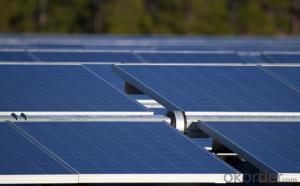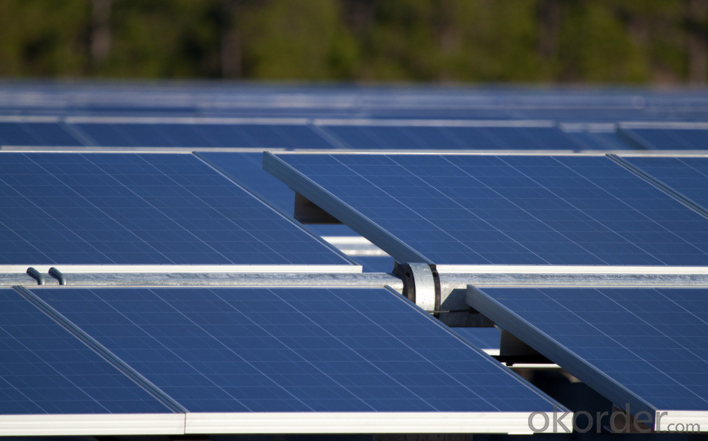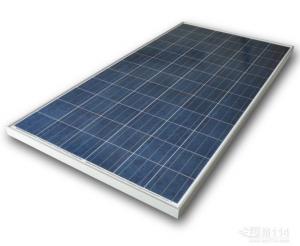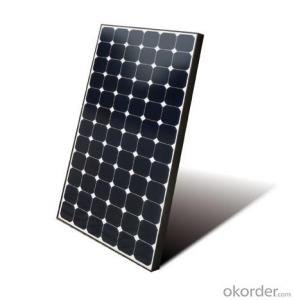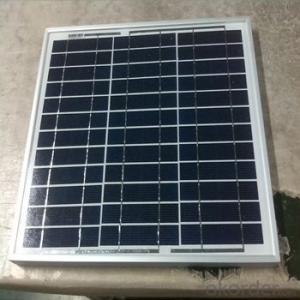Bp Solar Panels CNBM-K9 Series 10KW Solar Home System
- Loading Port:
- Shanghai
- Payment Terms:
- TT OR LC
- Min Order Qty:
- 1000 watt
- Supply Capability:
- 100000000 watt/month
OKorder Service Pledge
OKorder Financial Service
You Might Also Like
Specification
1.Description of the Solar Panel
Solar Home System CNBM-K9 Series 10KW Solar Panel
CNBM Solar's photovoltaic module is designed for designed for large electrical power requirement. It is the optimal choice for both on-grid and off-grid power systems. CNBM Solar offers high performance of power per square foot of solar array.
2.Characteristics of the Solar Panel
Inverter
Inverter | Rated load power | 10KW |
| Outout wave | Pure sine wave | |
| Input voltage | DC 220V | |
| Output voltage | AC 220V | |
| Output frequency | 50HZ | |
| Precision of output frequency | ±0.04HZ | |
| Solar panel | Pmax | 200W*55PCS |
| Vmp | 26.84V*11 | |
| Imp | 7.45A*5 | |
| Charger controller | Charger voltage & current | 220V/50A |
| Battery | Capacity | 12V150AH*18*2PCS |
| Support | aluminum | 11PCS/SET*5 |
| Power box | Spary paint iron box, with input, output, ammeter, volmeter, master switch and so on. | |
| Electrical loads in Winter (For Consult) | Electrical loads in Summer (For Consult) | ||||||||
| Name of Load | Power(W) | Quantity | Working Time per Day(H) | Working Days | Name of Load | Power(W) | Quantity | Working Time per Day(H) | Working Days |
| Color TV | 80W | 2 | 5 | 3 days | Color TV | 80W | 3 | 6 | 1.5 days |
| Fridge | 180W | 1 | 8 | 3 days | Fridge | 180W | 1 | 8 | 1.5 days |
| lamp | 11W | 4 | 5 | 3 days | lamp | 11W | 4 | 8 | 1.5 days |
| Computer | 150w | 2 | 5 | 3 days | Computer | 150W | 2 | 5 | 1.5 days |
| Heater | 1200W | 2 | 4 | 3 days | Air-conditioner | 1500W | 3 | 5 | 1.5 days |
3.Package Data of the solar Panel
| Part | Size(L*W*Hmm) | Weight(kg) | 20'(pcs) | 40'(pcs) |
| Power box | 500*550*1500 | 140 |
6pcs |
8pcs |
| Solar panel | 1482*992*40 | 450 | ||
| Battery | 1100*520*650*4 | 1100 |
4.Applications of the Solar Panel
1.Small power supply
2.transportation
3.Family power of lamps and lanterns
5.IMages of the Solar Panel

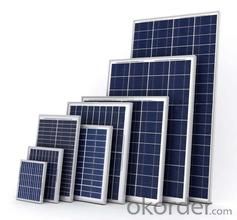
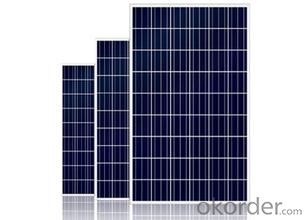
FAQ
1. Q: Do you have your own factory?
A: Yes, we have. Our factory located in Jiangyin city, jiangsu province.
2. Q: How can I visit your factory?
A: Before you take off from your country, please let us know. We will show you the way,or arrange time to pick you up if possible.
3. Q: Do you provide free sample?
A: Usually we do not offer free sample
4. Q: Could you print our company LOGO on the nameplate and package?
A: Yes, we can do that.
- Q: I am confused. I am planning to build a simple 2Watt solar system to power some lights in my house. . I wonder if it is possible to power up a 2Watt bulb using 2Watt solar power?2. Normally, when we are reading the power rating of a bulb, we will read the wattage, so what about the voltage and current rating?3. If the current is insufficient, will the bulb light up?I am having a solar panel that can output 2W power but I am not sure about the output voltage, how can I find out about the current? I am getting really confused.
- . Practically no. You have to account for startup current, and losses in the system. Ideally you would size your solar planel to provide the power you need to charge batteries in the day, for your needs at night. 2. Watts=Volts times Amps Really you just need to match the load and supply for volts, and make sure the supply has enough capacity to run your load. Current will take care of itself., in that the load will take what it needs to do its work. 3. It will bring the voltage down, causing the light to be dimmer.
- Q: I'm thinking of these solar panels that people have on their rooftops in domestic properties. I suppose I mean after how long do you break even with respect to just carrying on without them and getting you electricity from the utilities companies? Or answer in any way you think is pertinent. The more info the better.
- It's generally stated that it takes 0 years for them to pay for themselves. But the concept of paying for themselves is a primitive concept used by those who do not understand finances. You're still losing money when it pays for itself. A more appropriate analysis would be the Internal Rate of Return calculations, Excel makes this calculation easy. Overall,?solar power?is expensive power and works out about 38 cents per kwh ( proper economic estimates typically place it between 23 cents to 45 cents per kwh ). Some idiot here will insist solar doesn't cost that much per kwh, it does unless you're uneducated in finance. Note, it's also not clear if the energy produced by?solar panels?exceeds the energy required for their manufacture, delivery and installation. It takes a lot of energy to melt silicon and the costs triple if you try to recycle the toxic wastes which is why the panels are made where it's still possible to dispose of the toxic wastes. They could very well be causing more environmental damage then they save. With the Europeans what happens is the feed in tariffs makes the solar panels worthwhile. They still don't really pay for themselves but they allow you to take some of the tax money from your neighbors, a bit of an ethical dilemma really but ethics never stopped Europeans.
- Q: Single crystal solar panels and polycrystalline solar panels
- monocrystalline silicon market share and a slight increase, and now the market to see the majority of single-crystal silicon cells. Monocrystalline silicon solar cell silicon crystal is very perfect, its optical, electrical and mechanical properties are very uniform, the color of the battery is mostly black or dark, especially for small pieces of small pieces of consumer products.
- Q: do solar panels create electricity from the ultraviolet light created from the sun? because they only have an efficientcy of like 8% and this scientist found out a way to collect the visible light also, and he says the solar panel could have an effeciency of up to 80%! so my question really is, do solar penels creat electricity from heat? do you know of anything that can?
- They create electricity from light energy provided by the sun....
- Q: Is there a material that is capable of absorbing enough UV radiation to make it worth using as a flexible solar cell?Not flexible as in aluminum, but a material such as plastic (polycarbonate).
- Of Coarse! In fact flexible solar panels have already been invented. Ever hear of a solar panel shirt? Instead of the standard crystalline silicon cell these new solar panels use a flexible polymorphous silicon cell to pull in power from the sun's rays. They can be placed on clothing, cell phones, and virtually anything else.
- Q: I'm thinking of getting a solar panel for my house to help cut back on power use (I live in New Mexico). What sort of appliances can I run on a watt solar panel? Is it worth it to get a single watt panel or is it more efficient to get a multi-watt panel?
- You can run a lot of things. If you set the system to charge batteries when you are not using anything, they will charge effectively. You can use the system for lighting, LED lighting direct from the battery power is most effient since LEDs are low voltage devices with a very long life span. I replaced a 2 tube flourescent trough with four 5Watt PowerLEDs for example, While I have it on 20VAC at the moment, I can move it to 2 VDC power with ease, and had set it up to run initially on 2 volt sources. There are also many 2 volt appliances as well. You can even convert some of those all in one stereo systems to operate on 2 volts by eliminating the power supply. You will actually use less power by doing so. You will not be able to blow the shingles off the roof unless you add a Class D amplifier to the output, but for most listening, the output is adequate. Some small TV's these days can be run from 2 volt sources, if not directly, then with a buckboost inverter for a laptop. The small TVs only draw about 30 to 45 Watts. Skip the idea of using an inverter, they are not efficient at small loads, and represent additional load on the system. So with a little bit of planning, you can run a lot from that 60 Watt system. You can at least take some bite out of the electric bill for mundane lighting. You can also use them to keep power up on a battery system for lighting in a remote barn. The uses are only limited by your imagination and creativity.
- Q: My family moved into a house that came with solar power panels but they are not connected and don't really understand how to even begin.
- You will need help with this. Panels may or may not be 24 volt. If you can find a name tag, you can find out from the manufacturer's web site. Some folks hook them all in parallel. Mine are in series, to create 480 volts. the reason for going to higher voltage is to reduce power loss in the wiring. Even then, I used a wire size larger than recommended. The frames want to be interconnected, and wired to ground. The live conductors connect through disconnect switches to an inverter. The inverter is sized to the output of the panels. Where the utility allows net metering, the inverters are connected through a disconnect switch to the grid, which of course also feeds the house. Assuming you are on the grid, you will not need batteries. If outages severely impact you, you can have batteries. Counting against them is that they are costly, and use part of the power you generate, just to keep them charged. If you have batteries, it is usually best to rewire circuits so noncritical circuits are disconnected during outages. Leaving perhaps minimal lighting, fridge, freezer and critical medical circuits. Learn all you can from the Internet (try solar panels), and from the green search box above. Be sure to see if your state has a rebate program, and the conditions which it requires.
- Q: Can solar panels be used in areas with high levels of saltwater exposure?
- Yes, solar panels can be used in areas with high levels of saltwater exposure. However, regular maintenance and cleaning may be required to remove salt deposits and prevent corrosion. Additionally, using materials with high corrosion resistance, such as marine-grade stainless steel, can help prolong the lifespan of the solar panels in such environments.
- Q: Can solar panels be used for charging laptops or smartphones?
- Yes, solar panels can be used for charging laptops or smartphones. Portable solar panels, such as those designed for outdoor activities or camping, are available in the market. These panels can convert sunlight into electricity and charge your devices through USB ports or power banks. Additionally, some laptops or smartphones also have the capability to directly charge from solar panels using special adapters or cables.
- Q: The inverter I am using gets the required 2 DC volts from the solar panel, but fo some reason it just won't output the 0 AC voltage. When the inverter is hooked to a car battery, it works just fine off the same 2 DC rating. Help me out please...
- There could be a couple of reasons why it isn't working. First, 2V panels actually put out a considerably higher voltage because it is presumed that they will be used to charge a 2Vdc battery. That requires applying a voltage greater than 2Vdc, and usually there is a solar controller that regulates the solar power to the battery. It also has a voltage drop. Look at the first reference reference, and you will see these values for a particular panel: Voc: 2.6V (open circuit voltage) Vmp: 7.2V (voltage at maximum power point) Voc is the voltage the panel produces under standard sunlight and temperature conditions (25°C), with no load applied. As load is applied, the voltage drops (see reference 2). Power is the product of current times voltage, so at one set of conditions (namely at Vmp) maximum power is available from the panel. Your inverter might not be working for either of two reasons: ) it has input protection circuitry that locks out operation when it senses an overvoltage, as in the 2.6V open circuit voltage, or 2) the panel does not produce enough current and the voltage from the panel collapses under excessive load. For example, if you load your inverter to 20W, then nominally the 2VDC input to the inverter must supply 20W/2V/eff = 0A/eff Assuming the inverter has an efficiency of 80%, the input current required is: 0A/.8 = 2.5A A solar panel operating at maximum power would need a rating of about: 2.5A x 7.2V = 25W Is your panel that big? The other option, as mentioned by others, is to charge a battery that runs the inverter. Other nuances: Voc increases as temperature decreases. Sunlight intensity varies (obviously), so the panel may produce less than rated power. The power specifications often are printed on the back side of the panel.
Send your message to us
Bp Solar Panels CNBM-K9 Series 10KW Solar Home System
- Loading Port:
- Shanghai
- Payment Terms:
- TT OR LC
- Min Order Qty:
- 1000 watt
- Supply Capability:
- 100000000 watt/month
OKorder Service Pledge
OKorder Financial Service
Similar products
Hot products
Hot Searches
Related keywords





